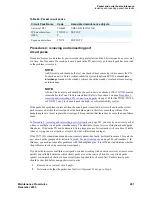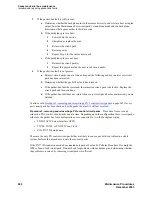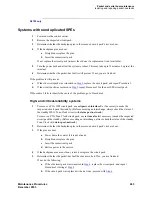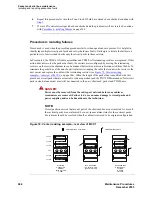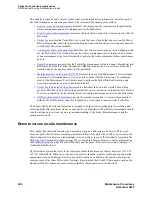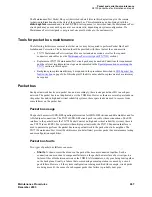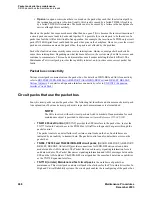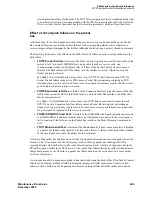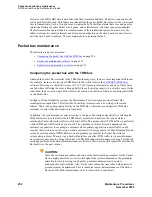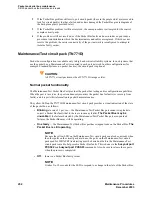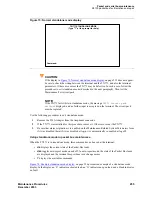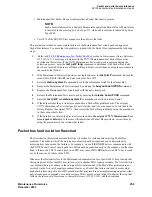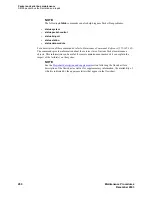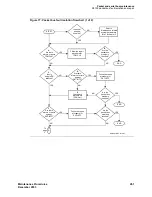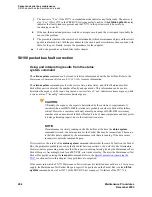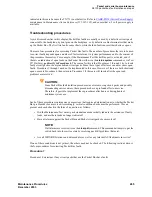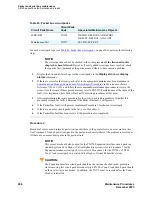
Packet and serial bus maintenance
S8100 packet bus fault isolation and repair
Maintenance Procedures
253
December 2003
In normal switch operation, the Maintenance/Test provides the visual feedback of the Packet Bus state.
When standalone mode (described in the next section) is in effect, these visual indications are still
provided; however, the Packet Bus is never reconfigured, and, as a result, the yellow LED either blinks or
is off.
Standalone mode
The TN771D Maintenance/Test provides a standalone mode for detecting Packet Bus faults. In the
standalone mode, a terminal is connected to the Maintenance/Test circuit pack through the Amphenol
connector on the back of the cabinet. This setup allows the System Technician to determine the state of
the Packet Bus without having to access the Manager I terminal to provide these functions, even if the
switch is not in service. Note that the Maintenance/Test does not reconfigure the Packet Bus when it is
operating in standalone mode.
Standalone mode is used in the Packet Bus Fault Correction procedures. As a result, a TN771 and a
corresponding terminal must be available to the technician who is to perform such procedures. A
High or Critical Reliability system has a TN771 in each port network. However, the customer of a system
that does not have High or Critical Reliability may have purchased a TN771 for ISDN-PRI trunk testing,
or to increase the system’s ability to detect Packet Bus failures.
The
list configuration
command is used to check for the presence of a circuit pack in the system. If a
circuit pack is not present in the system, one must be taken to the customer site. The
section in this chapter discusses the special cases when a spare TN771 must be
taken to the customer site.
NOTE:
When in standalone mode, the yellow LED on the TN771 blinks if there is a Packet Bus
fault. If there is no such fault, the yellow LED is off. This is true because Packet Bus
reconfiguration cannot occur in standalone mode.
Required hardware for standalone mode
In addition to the TN771, the following equipment is required to use the standalone mode:
•
Terminal or PC with terminal-emulation software. The EIA-232 (RS-232) port should be
configured at 1200 baud, no parity, 8 data bits, and one stop bit. This is
not
the same
configuration as for the Manager I terminal. Therefore, if the Manager I can be used for this
operation (and this depends on the switch configuration and on customer requirements),
remember to restore the original communication parameters before returning the Manager I to
service.
•
355A EIA-232 Adapter
•
258B Six-Port Male Amphenol Adapter
•
D8W 8-wire modular cable of an appropriate length to connect the 258A on the back of the
cabinet to the 355A adapter.
Selecting a carrier slot for standalone mode
When selecting a carrier slot to use for standalone mode in a port network that does not already contain a
TN771, keep the following points in mind:
1
A port circuit slot (indicated by a purple label) should be used.
2
-5 volt power supply must be available in the carrier. This section describes the power supply
configurations that provide this power supply.
Summary of Contents for CMC1
Page 1: ...Maintenance Procedures 555 245 103 Issue 1 1 December 2003 ...
Page 14: ...Contents 14 Maintenance Procedures December 2003 ...
Page 416: ...Additional maintenance procedures IP Telephones 416 Maintenance Procedures December 2003 ...
Page 426: ...Index X 426 Maintenance Procedures December 2003 ...



